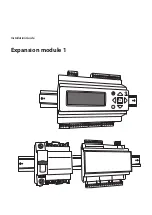
8
EN
■
ACV BM R 31 OIL BURNER
◆
DESCRIPTION
This new generation of oil burners meets current gas performance
and hygiene requirements. The burner is fitted with top quality
components using the latest technology and the oil is preheated.
Components: • “Landis & Gyr” relay
• “A.E.G” motor
• “Suntec” pump
• “May & Christe” transformer
• “Landis & Gyr” oil preheating unit
◆
ADVANTAGES
•
Easy to install, fitted with a safety latch and a new burner
suspension system.
•
The burner is shipped with a special key to be used for all
maintenance work.
•
The burner’s air pressure adapts to the combustion chamber
pressure.
•
An automatic check valve halts the air flow when the burner
stops and thus prevents the boiler from cooling down.
•
Quiet and extremely reliable.
•
Can be adapted to the depth of the boiler chamber using the
adjustable flange on the throat.
•
Three air adjustment points to give the best possible air/oil mix.
- upstream air pressure can be preset
- primary setting
- combustion head setting.
◆
LEGEND OF BM R 31 OIL BURNER
(see illustration R)
1.
Relay
2.
Photoelectric cell
3.
Burner connector
4.
Solenoid valve
5.
Pump
6.
Motor
7.
High voltage transformer
■
ACV BM 1 LN 1 OIL BURNER
◆
DESCRIPTION
To fit out our ALFA Fuel boiler with air valve, we needed a really high
performance burner to give perfect combustion. We opted to use the
brand new technology of the BM 1 LN 1 blue burner.
◆
ADVANTAGES
•
Very high pressure fan, particularly useful in dealing with pressure
drops in pipes on boiler fitted with balanced flue.
•
Special pump with built-in magnetic valve and by-pass set to 3
bar which allows the burner to be shut off, an oil return at hig
pressure in line with the nozzle
(reduces dirt on the flame holder an
the boiler).
•
The flame axis is very close to the bottom of the burner chamber.
•
Air is set using an original process.
•
Mixing device using recirculation for combustion low in harmful
emissions, making the optimum use of the energy released.
•
Quiet in operation.
◆
ADJUSTMENT PARAMETERS
Nozzle: HAGO 0.75 GPH 60° DFN
Distance between nozzle and flame holder: 2.5 to 3 mm
Pump pressure: 12 bar
Presetting the air: • air valve upstream of the fan: 4 to 4,5
• secondary air gauge: 3
• throat pressure: 2 to 2.5 mbar
• CO
2
range: see curve
• blackening index < 0.5
◆
ADJUSTMENT PROCEDURE
•
Fit the nozzle onto the burner, adjust the distance between the
nozzle and the flame holder,
•
Preset the air adjustments,
•
Start up the burner and adjust the pump pressure,
•
After 7 minutes, adjust the CO
2
according to the attached diagram,
paying attention to the air pressure at the throat,
•
Stop the burner for 5 minutes and check that it has started up
properly. If not, change the settings
(reduce the air pressure at the
throat and adjust the CO
2
).
◆
CO
2
DIAGRAM FOR THE BM 1 LN 1 BURNER
◆
LEGEND OF BM 1 LN 1 OIL BURNER
(see illustration S)
1.
Nozzle
2.
Flame holder
3.
Relay
4.
Solenoid valve
5.
Pump
6.
Motor
7.
Throat
8.
Air circulation ring
F
FV
Burner
BM R 31
BM 1 LN 1
Output
kW
21 / 38
34,9
Electrical power
W
150
150
Nozzle
gal/h
0,75
Hago 0,75
Nozzle angle
60°
60° DFN
Oil flow rate
Kg/h
2,53
2,95
Pump pressure
bar
10,5
15
Flue gas index
0,6
0
Air flap setting
4,5
4,5
Combustion head setting
1
2 - 3
Flue pressure drop
mbar
0,07
-
Weight
Kg
12
12
◆
OIL BURNERS - Factory settings
14 %
13,5 %
13 %
12,5 %
12 %
-10
0
10
20
30
40
% CO
2
External temperature
■
USER GUIDE
■
USING THE BOILER
◆
LEARNING YOUR WAY AROUND THE CONTROL PANEL
(see illustration B)
Before carrying out any work on the boiler, switch the
power off at the external isolator.
Turn the ON/OFF switch on the control panel off.
(item marked 2, illustration B)


































